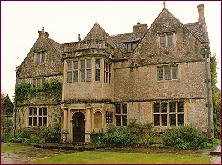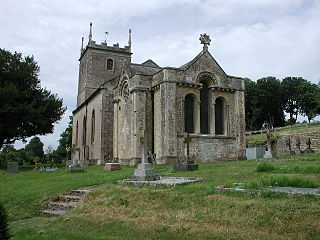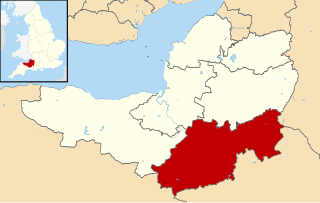
Lyme Park is a large estate south of Disley, Cheshire, England, managed by the National Trust and consisting of a mansion house surrounded by formal gardens and a deer park in the Peak District National Park. The house is the largest in Cheshire, and is recorded in the National Heritage List for England as a designated Grade I listed building.

Stourhead is a 1,072-hectare (2,650-acre) estate at the source of the River Stour in the southwest of the English county of Wiltshire, extending into Somerset. The estate is about 4 km northwest of the town of Mere and includes a Grade I listed 18th-century Neo-Palladian mansion, the village of Stourton, one of the most famous gardens in the English landscape garden style, farmland, and woodland. Stourhead has been part-owned by the National Trust since 1946.

St Catherine's Court is a manor house in a secluded valley north of Bath, Somerset, England. It is a Grade I listed property. The gardens are Grade II* listed on the Register of Historic Parks and Gardens of special historic interest in England.

Badminton House is a large country house and Grade I Listed Building in Badminton, Gloucestershire, England, which has been the principal seat of the Dukes of Beaufort since the late 17th century. The house, which has given its name to the sport of badminton, is set among 52,000 acres of land. The gardens and park surrounding the house are listed at Grade I on the Register of Historic Parks and Gardens.

Curry Rivel is a village and civil parish in Somerset, England, situated 6 miles (9.7 km) west of Somerton and 10 miles (16.1 km) east of Taunton in the South Somerset district. The parish has a population of 2,148. The parish includes the hamlet of Burton Pynsent.

Milborne Port is a village, electoral ward and civil parish in Somerset, England, east of Sherborne, and in the South Somerset district. It has a population of 2,802. The parish includes the hamlets of Milborne Wick and Kingsbury Regis.

Charlton House is a Jacobean building in Charlton, within the Royal Borough of Greenwich in south-east London. Originally it was a residence for a nobleman associated with the Stuart royal family. It later served as a wartime hospital, then a museum and library, and is now run by Royal Greenwich Heritage Trust.

Hestercombe House is a historic country house in the parish of West Monkton in the Quantock Hills, near Taunton in Somerset, England. The house is a Grade II* listed building and the estate is Grade I listed on the English Heritage Register of Parks and Gardens of Special Historic Interest in England.

Dodington Park is a country house and estate in Dodington, South Gloucestershire, England. The house was built by James Wyatt for Christopher Bethell Codrington. The family had made their fortune from sugar plantations in the Caribbean and were significant owners of slaves. It remained in the Codrington family until 1980; it is now owned by the British businessman James Dyson.

The Medlycott Baronetcy, of Ven House in the County of Somerset, was a title in the Baronetage of the United Kingdom. It was created on 3 October 1808 for William Medlycott, Member of Parliament for Milborne Port from 1790 to 1791. The family descended from James Medlycott, of Ven House, who represented Milborne Port in the House of Commons between 1710 and 1722. His son Thomas Medlycott died without surviving male issue in 1763 and left his estates to his maternal nephew Thomas Hutchings, who adopted the surname of Medlycott. His son was the first Baronet. The baronetcy became extinct with the death of the 9th Baronet in 2021.

Marston Bigot is a small village and former civil parish, now in the parish of Trudoxhill in the Somerset district, in the ceremonial county of Somerset, England. It is near Nunney and 3 miles (5 km) south of Frome. In 1931 the parish had a population of 117.

Redlynch is a village and former manor in the civil parish of Bruton, in the South Somerset district of Somerset, England. The 18th-century church and a folly named The Towers are of architectural interest.
Stiff Leadbetter was a British architect and builder, one of the most successful architect–builders of the 1750s and 1760s, working for many leading aristocratic families.

The Grade I listed buildings in Somerset, England, demonstrate the history and diversity of its architecture. The ceremonial county of Somerset consists of a non-metropolitan county, administered by Somerset County Council, which is divided into five districts, and two unitary authorities. The districts of Somerset are West Somerset, South Somerset, Taunton Deane, Mendip and Sedgemoor. The two administratively independent unitary authorities, which were established on 1 April 1996 following the breakup of the county of Avon, are North Somerset and Bath and North East Somerset. These unitary authorities include areas that were once part of Somerset before the creation of Avon in 1974.

The Church of St John the Evangelist in Milborne Port, Somerset, England is a cruciform church of late Anglo-Saxon date and parts may well span the Norman conquest. The church has been designated by English Heritage as a Grade I listed building.

South Somerset is a local government district in the English county of Somerset. The South Somerset district occupies an area of 370 square miles (958 km2), stretching from its borders with Devon and Dorset to the edge of the Somerset Levels. The district has a population of about 158,000, and has Yeovil as its administrative centre.
Nathaniel Ireson was a potter, architect and mason best known for his work around Wincanton in Somerset, England.
Burton Pynsent House is a historic country-house in the parish of Curry Rivel, Somerset, England. It is a Grade II* listed building. The house was built in stages between 1565 and 1765, when it was bequeathed to William Pitt, 1st Earl of Chatham by Sir William Pynsent, 2nd Baronet, who did not want the house to go to Lord North. Pitt had an additional wing built to a design by Lancelot Brown, and the subsequent owner demolished everything but this wing in 1805.

Barrow Court is a manor house in Barrow Gurney, Somerset, England. The site was originally Barrow Gurney Nunnery and was rebuilt in the 16th and 19th centuries. It has been designated as a Grade II* listed building.

Milborne Port Town Hall is a municipal building in the High Street in Milborne Port, Somerset, England. The structure, which serves as meeting place of Milborne Port Parish Council, is a Grade II listed building.


















